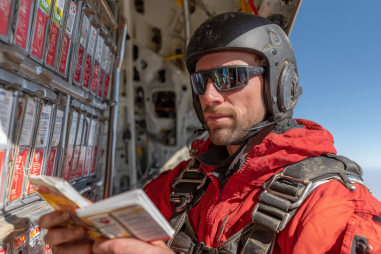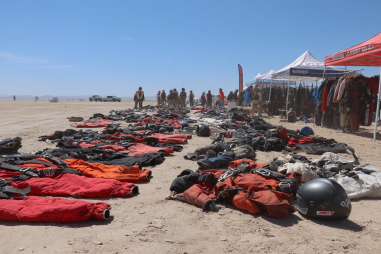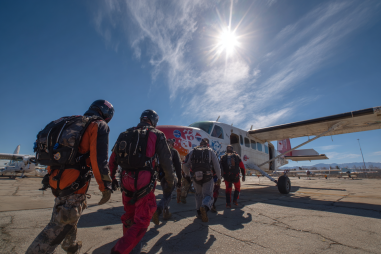When it comes to skydiving, the thrill of soaring through the sky is matched only by the utmost importance of safety measures. Among these, packing your parachute correctly is a crucial step that can mean the difference between an exhilarating jump and a dangerous malfunction. Proper packing ensures that your canopy deploys reliably and performs optimally during descent, providing peace of mind so you can fully enjoy the adventure. Whether you’re a seasoned jumper or new to the sport, understanding and mastering skydiving safety procedures for packing parachutes is essential for a safe experience.
Tools and Environment for Safe Packing
Before you start packing your parachute, ensuring the right tools and environment is key to maintaining focus and avoiding mistakes. A clean, flat packing area free from dirt and debris helps protect the fabric and lines from damage. Many skydivers prefer to pack indoors or in sheltered outdoor locations where wind won’t scatter the lines or create distractions.
Essential tools for packing include a packing mat or tarp, which provides a smooth surface and prevents dirt from sticking to the canopy, and a packing hook or line organizer to keep suspension lines neat and orderly. Additionally, a winders or rubber bands can help keep the folds compact without compressing the fabric excessively. Having a checklist nearby is also useful to ensure every step is covered systematically.
Step-by-step Parachute Packing Guide
Packing a parachute follows a precise sequence of steps that must be performed meticulously. While variations exist depending on parachute model, the core procedure generally includes the following steps:
- Inspect the canopy and lines: Unfold the canopy fully and check for tears, holes, or damage to the fabric. Examine suspension lines for frays or knots, ensuring they run freely from risers to canopy.
- Smooth and fan out the canopy: Lay the canopy flat on the packing surface, spreading it evenly to eliminate creases and bunching. Align the lines carefully, preventing tangles.
- Fold the canopy: Using the chosen packing technique (e.g., flat pack or pro pack), fold the canopy in panels that keep the fabric orderly, without sharp creases.
- Arrange suspension lines: Align the lines along the folds, organizing them neatly using rubber bands or line organizers, avoiding any twists or loops.
- Flake and stow lines: Flaking the lines in a smooth hand-over-hand motion prevents snags during deployment. Stow them into the deployment bag’s designated compartments appropriately.
- Close the deployment bag: Fold and secure the deployment bag flaps, ensuring that the pilot chute and bridle are correctly positioned and that the closing loop passes through the closing pin.
- Secure the rig: Place the packed parachute into the container and close it according to manufacturer instructions, verifying closing pins and seals are properly in place.
Following these detailed steps carefully helps guarantee a flawless deployment when you jump.
Common Errors and How to Avoid Them
Even experienced packers can make mistakes, and some errors can have serious consequences. Awareness of common pitfalls allows you to avoid them effectively:
- Line twists or tangles: Improperly aligned or stowed lines can lead to twists that cause canopy malfunction. Using a methodical approach to flaking and securing lines helps prevent this problem.
- Improper folding: Folding the canopy unevenly or forcing fabric into tight creases can weaken the material and interfere with deployment. Patience and gentle handling are critical.
- Damaged equipment: Skipping the inspection process or failing to report tears or worn lines compromises safety. Always inspect thoroughly and remove damaged gear from use.
- Incorrect closing: Misplaced closing loops or pins can cause the container to release prematurely or delay opening. Double-check the rig’s closure every time.
Taking your time and adhering to standard practices minimizes these risks and ensures a safer skydiving experience.
Inspecting the Pack Before Use
Before every jump, a final comprehensive inspection of your packed parachute is essential. This includes examining the container for any damage, ensuring the integrity of the closing system, and confirming the pilot chute’s readiness. Checking the canopy and lines once more if possible adds an extra layer of safety, catching any issues that might have been missed initially.
If you notice anything unusual or wear signs that concern you, do not hesitate to consult a certified rigger or instructor before proceeding. It’s far better to delay a jump than risk your life by using compromised equipment.
Training to Become a Certified Packer
Packing a parachute correctly is a skill that requires dedicated training. Many drop zones and skydiving schools offer courses to become a certified parachute packer. These programs teach the detailed techniques and safety protocols essential for professional packing, including how to inspect gear properly, recognize signs of wear, and adhere to manufacturer guidelines.
Certification typically involves both classroom instruction and practical assessments, ensuring that packers can perform consistently under different conditions. Becoming certified not only enhances your safety but also contributes to the broader skydiving community’s well-being by maintaining high standards for gear readiness.
Staying Updated on Packing Techniques
Skydiving equipment and best practices evolve over time. Staying informed about new packing methods, equipment innovations, and safety recommendations is crucial for all skydivers and packers. Engaging with skydiving forums, attending refresher courses, and participating in workshops can help you stay current.
Manufacturers may release updated manuals or safety notices, so regularly reviewing official documentation ensures you remain compliant with the latest standards. Networking with other experienced packers also provides valuable tips and shared experiences that can improve your skills.
Ensuring Every Jump Is a Safe One
Mastering the safety procedures for packing parachutes is an indispensable part of the skydiving journey. By working in a clean and organized environment, following a step-by-step packing process, avoiding common mistakes, and conducting thorough inspections, you significantly reduce the chances of equipment failure. Pursuing professional training and staying updated on best practices further strengthens your ability to keep yourself and others safe in the air.
When your parachute is packed correctly, it translates into reliable deployment, optimal control, and a more enjoyable experience every time you jump. Treat your parachute with the respect and care it deserves—and take your skydiving adventures to new heights with confidence and safety.







